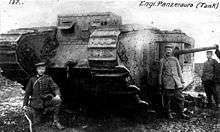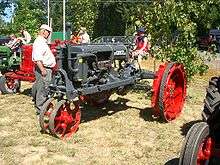Grouser
Grousers are devices intended to increase the traction of continuous tracks, especially in loose material such as soil or snow. This is done by increasing contact with the ground with protrusions, similar to conventional tire treads, and analogous to athletes' cleated shoes. On tanks and armoured vehicles, grousers are usually pads attached to the tracks; but on construction vehicles they may take the form of flat plates or bars.[1]
Similar traction-improving patterns have been implemented on the surface of the wheels on tractors. These include strakes, where material is removed from the surface of the wheel to achieve protrusion; cleats, with spikes instead of straight bars; and lugs with raised rubber on a tire tread.
.jpg)
Variations
Developed during World War I, external track extensions – often called "grousers" or "duckbills" – were added to the outside edges of the trackshoes on armored fighting vehicles such as tanks, widening the track for improved performance in snow or mud.[2] Track segments (i.e., trackshoes) which incorporate grouser bars are known as grouser shoes, and typically include one to three grousers.[3]
Grousers are commonly used on construction vehicles such as bulldozers, loaders, and excavators. Grousers may be permanently attached to, or formed as a single piece with, the track shoe, or they may be bolted onto the track shoe for ease of replacement as they become worn. While grousers are usually straight, they may have more complex shapes, including spikes[4] and involute curves, depending on the type of terrain and the performance requirements of the vehicle.[5] Grousers are typically made of metal, such as forged steel, and are not designed for use on paved roads.[4] Various devices, with names such as road bands, have been developed to temporarily cover grousers/cleats in order to allow a vehicle to drive on paved roads.
Grousers have been used in such exotic environments as the deep sea floor, and the surfaces of the Moon and Mars.[5] Snowmobiles once used cleated tracks, but racing snowmobiles are banned from using cleated track for safety reasons and instead use rubber tracks.[6]
Protrusions molded into rubber tractor tire treads are known as lugs, as are cleats for round wheels, which perform a similar function. Unlike metal grousers, these rubber tire treads or crawler-track shoes/pads may be more suitable for driving on roads.

Terramechanics
Grousers function by trapping soil against the contact area of the track. It is the shearing of the soil against itself that generates tractive force. The gross tractive effort, or soil thrust, of a vehicle may be calculated from the equation:[7]
where:
- soil thrust
- track width
- contact length
- coefficient of cohesion (a soil property)
- grouser height
- gross vehicle weight
- angle of repose (a soil property)
Gallery
|
See also
References
- ↑ Various (2003). "Forum Posts". Axis History Forum. Retrieved 18 Oct 2015.
Admfisher:"Track pads on a modern bulldozer would have normally a single grouser pad. That is the part of the track that provides traction. Or simpler way of looking at it is, the bar that crosses the pad and is raised.";
Aufklarung:"On Ex/Winter we put in place of the rubber [pad] a steel plate in the shape of a raised "X". This we here call a "Grouser"." - ↑ Fletcher, David (2011). Mark V Tank. Osprey Publishing. p. 5. ISBN 978-1-84908-351-5.
- ↑ "Track Shoes". Berco of America, Inc. Retrieved 2010-02-27.
- 1 2 "Grouser Shoes". RitchieWiki. Ritchie Bros. Auctioneers. 13 October 2009. Retrieved 2010-02-27.
- 1 2 Hong, Sup; Jong-Su Choi (2001). "Experimental Study on Grouser Shape Effects on Trafficability of Extremely Soft Seabed" (PDF). Proceedings of the Fourth Ocean Mining Symposium. Szczecin, Poland: The International Society of Offshore and Polar Engineers. pp. 115–. Retrieved 2010-02-28.
- ↑ Dave Dunigan (2006). "Forum Posts". American Snowmobiler. Retrieved 18 Oct 2015.
They banned the cleated track the next year.
- ↑ Gerhart, Grant; Sean Laughery; Richard Goetz (2006). "Off-Road Vehicle Locomotion Using Bekker's Model". Warren, MI: United States Army Tank Automotive Research, Development and Engineering Center: 9. Retrieved 2010-02-28.



